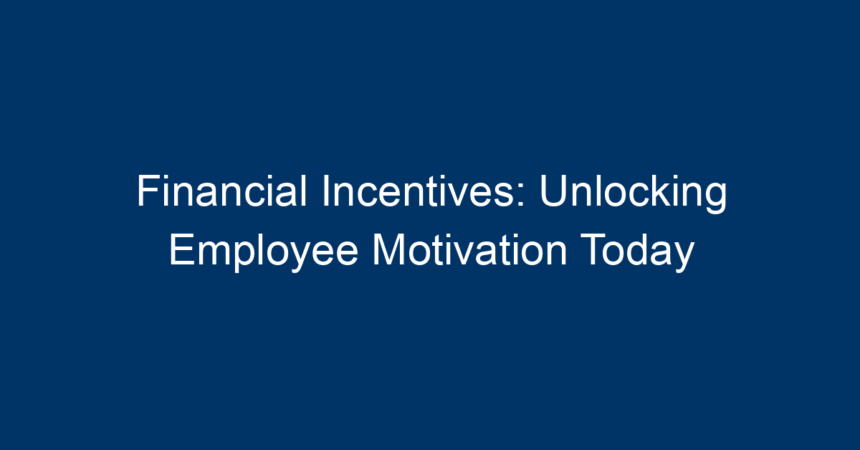In the ever-evolving landscape of human resources, the quest for unlocking employee motivation has never been more critical. Organizations continually seek effective methods to engage their workforce, and one approach that stands out is the use of financial incentives. These incentives are more than just bonuses or raises; they are powerful tools that can drive productivity, enhance loyalty, and create a thriving workplace culture. In this article, we will explore various types of financial incentives, their impacts on employee motivation, and actionable strategies for implementing them in today’s dynamic work environment.
Understanding Financial Incentives
Before diving into the specifics, it’s essential to clarify what financial incentives are. Financial incentives are monetary rewards that organizations offer to motivate their employees. They can come in various forms, including bonuses, profit-sharing, stock options, and merit-based pay increases. What unites these incentives is their intrinsic value—they provide employees with tangible benefits for their efforts and achievements.
The Psychology Behind Financial Incentives
Understanding the psychology behind financial incentives reveals why they can be effective motivators. According to motivational theories such as Maslow’s Hierarchy of Needs, financial rewards satisfy basic financial needs, allowing employees to focus on higher-level psychological needs such as belonging and esteem. When employees feel secure in their financial situation, they are likely to be more engaged and motivated at work.
Moreover, tying financial incentives to performance creates a sense of accountability and ownership among employees. When individuals know their efforts directly impact their financial rewards, they are more likely to strive for excellence.
Types of Financial Incentives
1. Bonuses
Bonuses are perhaps the most recognized form of financial incentive. They are typically one-time payments given for achieving specific targets or objectives. Bonuses can take various forms, such as:
- Performance Bonuses: Awarded for exceeding performance metrics.
- Holiday Bonuses: Given as a gesture of appreciation during festive seasons.
- Referral Bonuses: Paid to employees who successfully refer new hires.
2. Profit Sharing
Profit-sharing plans distribute a portion of the company’s earnings to employees, aligning their interests with the organization’s success. This financial incentive fosters a sense of partnership, where employees feel they are integral to the overall performance of the company.
3. Stock Options
Offering stock options enables employees to purchase shares in the company at a predetermined price. This long-term financial incentive can significantly boost motivation as employees become stakeholders in the organization’s success. When the company thrives, so do their potential earnings.
4. Merit-based Pay Increases
Merit-based pay increases reward employees for their individual contributions. This financial incentive not only boosts morale but also encourages continuous improvement and professional development.
5. Commission
For sales-oriented roles, commission is a critical financial incentive. Employees earn a percentage of the sales they generate, motivating them to increase their performance and drive revenue.
The Impact of Financial Incentives on Employee Motivation
Enhancing Performance
Financial incentives have a direct correlation with employee performance. When employees know that their hard work will be rewarded financially, they are more likely to put in the effort required to meet and exceed expectations. According to a study by the Harvard Business Review, organizations that effectively utilize financial incentives report a 25% increase in employee performance.
Fostering Teamwork
Team-based financial incentives, such as profit sharing or team bonuses, encourage collaboration and collective responsibility. Employees are motivated to work together, knowing their combined efforts will lead to financial rewards.
Improving Retention Rates
High turnover rates can be costly for organizations. By implementing financial incentives, companies can improve employee retention rates. Individuals who feel valued and rewarded for their work are less likely to seek opportunities elsewhere.
Boosting Job Satisfaction
Financial rewards contribute to overall job satisfaction. Employees who receive fair and consistent financial incentives are often more engaged and committed to their roles, creating a positive workplace culture.
Implementing Effective Financial Incentives
Aligning Incentives with Company Goals
To maximize the effectiveness of financial incentives, they must align with the organization’s goals. By tailoring incentives to encourage behaviors that drive the company forward, organizations can ensure that employees are motivated to contribute to shared success.
Establishing Clear Performance Metrics
Setting clear performance metrics is crucial for the success of financial incentives. Employees should understand what is expected of them and how their performance will be evaluated. Transparency fosters trust and ensures that employees perceive the system as fair and attainable.
Communicating Incentive Programs
Effective communication is vital when implementing financial incentives. Employees must be informed about the available incentives, how they work, and the criteria for earning them. Regular updates and feedback sessions can reinforce the importance of these programs and motivate employees to strive for their goals.
Offering a Variety of Incentives
Not all employees are motivated by the same financial incentives. Offering a diverse range of options—like bonuses, profit-sharing, and commissions—allows employees to select rewards that resonate with them personally. This tailored approach can significantly enhance motivation.
Regularly Reviewing Incentive Programs
Market conditions and employee preferences change over time. Regularly reviewing and updating financial incentive programs ensures they remain relevant and effective. Soliciting employee feedback can provide valuable insights into what motivates them and how incentives can be improved.
Actionable Insights
-
Assess Current Incentives: Evaluate existing financial incentive programs to assess their effectiveness and fairness. Make adjustments based on employee feedback and performance metrics.
-
Incorporate Non-Monetary Rewards: While financial incentives are essential, complementing them with non-monetary rewards—like recognition programs or professional development opportunities—can enhance overall motivation.
-
Foster a Culture of Transparency: Openly discuss financial performance and how employee contributions factor into overall success. Transparency builds trust and motivates employees to work toward common goals.
-
Provide Training and Support: Offer training to help employees reach their performance goals. Supportive supervisors can make a significant difference in motivating employees to achieve financial incentives.
- Celebrate Achievements: Recognize and celebrate both individual and team achievements related to financial incentives. Public recognition can reinforce the value of hard work and motivate others to strive for similar success.
Conclusion
Financial incentives play a crucial role in unlocking employee motivation today. By understanding their psychological impact, types, and implementation strategies, organizations can develop effective financial incentive programs that drive performance, enhance job satisfaction, and improve employee retention.
In a competitive business environment, investing in your employees through thoughtful financial incentives is not just a matter of rewarding hard work—it’s about creating a culture of motivation and success. By aligning financial incentives with organizational goals and continually assessing their effectiveness, companies can empower employees to reach their full potential. The time to act is now; financial incentives can transform your workforce and lead to unprecedented growth and success.




